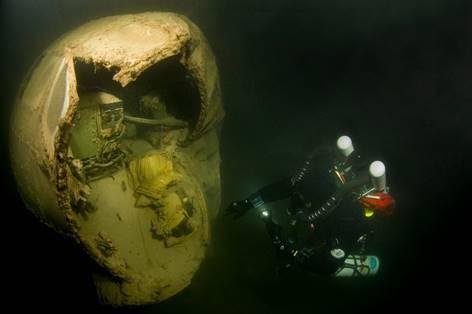
Lake Mead has been hitting records lows throughout the year, raising the specter of water cutbacks for Arizona and Nevada in the near future.The upshot for these scuba divers: the underwater wreckage is easier to explore, as Silverstein explained on the boat ride out. “On its crash, it sank in approximately 260 feet of water and that’s exceptionally deep for scuba diving,” Brown said.
Soon, the crew is wriggling into heavy insulated wetsuits, fastening straps and straddling tanks of nitrox. By the end they look like astronauts, not out of place in the moonscape of Lake Mead.John Fuller is the boat’s captain and one of the tour guides. Bobbing in the water, he gave Steve Brown a “dry run” before the descent.
“Then we’ll go around to the second place where the engine used to be,” Fuller said. “And look at the gigantic hole with all the pipes and tubes and wires and all the stuff. You’re thinking, ‘man, who designed something like that?’” At the time of its inception during World War II, the B-29 was a major leap forward for American military aviation. It could carry out bombing campaigns in the Pacific and was eventually entrusted with nuclear weapons.

An old military training video from the time described it as, “The plane you’ve been waiting for and it was worth waiting for. It’s the biggest, fastest, mightiest heavy bomber in the world.” Only one operational B-29 remains in the world today. From video below, you can make out the propellers lodged into the silty bottom, the cracked fuselage caked in mussels and the cockpit with the remains of a parachute, aglow in green murky light.
Since the plane was discovered in the early 2000s, the National Park Service and only about 60 people have dived the bomber, said Silverstein. There aren’t plans to pull it out of the water anytime soon, either. According to the National Oceanographic and Atmospheric Administration, the B-29 was one of the last built and was delivered to the U.S. Army eleven days after the end of World War II.
Image@Mel Clark

Δεν υπάρχουν σχόλια:
Δημοσίευση σχολίου